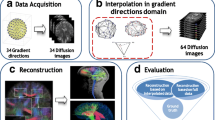Abstract
Purpose
Diffusion tensor imaging (DTI) is a non-invasive imaging technique that allows estimating the location of white matter tracts based on the measurement of water diffusion properties. Using DTI data, the fiber bundle boundary can be determined to gain information about eloquent structures, which is of major interest for neurosurgical interventions. In this paper, a novel approach for boundary estimation is presented.
Methods
DTI in combination with diverse segmentation algorithms allows estimating the position and course of fiber tracts in the human brain. For additional information about the expansion of the fiber bundle, the introduced iterative approach uses the centerline of a tracked fiber bundle between two regions of interest (ROI). After sampling along this centerline, rays are sent out radially, discrete 2D contours are calculated, and the fiber bundle boundary is estimated in a stepwise manner. For this purpose, each ray is analyzed using several criteria, including anisotropy parameters and angle parameters, to find the boundary point.
Results
The novel method for automatically calculating the boundaries has been applied to several artificially generated DTI datasets. Multiple parameters were varied: number of rays per plane, sampling rate and sampled points along the rays. For the DTI data used in the experiments, the method yielded a dice similarity coefficient (DSC) between 74.7 and 91.5%.
Conclusions
In this paper, a novel approach to retrieve significant information about the fiber bundle boundary from DTI data is presented. The method is a contribution to gather important knowledge about high-risk structures in neurosurgical interventions.
Similar content being viewed by others
References
Alexander AL, Hasan K, Kindlmann G, Parker DL, Tsuruda JS (2000) A geometric analysis of diffusion tensor measurements of the human brain. Magn Reson Med 44: 283–291
Barbieri S, Klein J, Nimsky C, Hahn HK (2010) Assessing fiber tracking accuracy via diffusion tensor software models. In: SPIE—medical imaging
Basser PJ, Jones DK (2002) Diffusion-tensor MRI: theory, experimental design and data analysis—a technical review. NMR Biomed 15: 456–467
Bihan DL, Mangin JF, Poupon C, Clark CA, Pappata S, Molko N, Chabriat H (2001) Diffusion tensor imaging: concepts and applications. J Magn Reson Imaging 13: 534–546
Ding Z, Gore JC, Anderson AW (2001) Case study: reconstruction, visualization and quantification of neuronal fiber pathways. In: VIS ’01: proceedings of the conference on visualization ’01, IEEE Computer Society, pp 453–456
Hasan KM, Alexander AL, Narayana PA (2004) Does fractional anisotropy have better noise immunity characteristics than relative anisotropy in diffusion tensor MRI? An analytical apprach. Magn Reson Med 51: 413–417
Hornung A, Kobbelt L (2006) Robust reconstruction of watertight 3D models from non-uniformly sampled point clouds without normal information. In: SGP ’06: proceedings of the fourth eurographics symposium on Geometry processing, Eurographics Association, pp 41–50
Klein J, Hermann S, Konrad O, Hahn HK, Peitgen HO (2007) Automatic quantification of DTI parameters along fiber bundles. In: Proceeding of image processing for medicine (BVM 2007), pp 272–2
Merhof D, Hastreiter P, Nimsky C, Fahlbusch R, Greiner G (2005) Directional volume growing for the extraction of white matter tracts from diffusion tensor data. In: SPIE—medical imaging 2005: visualization, image-guided procedures, and display, vol 5744, pp 165–172
Merhof D, Meister M, Bingl E, Nimsky C, Greiner G (2009) Isosurface-based generation of hulls encompassing neuronal pathways. Stereotact Funct Neurosurg 87: 50–60
Mori S, van Zijl PCM (2002) Fiber tracking: principles and strategies—a technical review. NMR Biomed 15: 468–480
Nimsky C, Ganslandt O, Enders F, Merhof D, Hammen T, Buchfelder M (2005) Visualization strategies for major white matter tracts identified by diffusion tensor imaging for intraoperative use. International Congress Series 1281: 793–797. CARS 2005: Computer Assisted Radiology and Surgery
Ou Y, Wyatt C (2005) Visualization of diffusion tensor imaging data and image correction of distortion induced by patient motion and magnetic field eddy current. In: Virginia Tech—Wake Forest University School of Biomedical Engineering and Sciences 4th student research symposium
Peeters THJM, Rodrigues PR, Vilanova A, ter Haar Romeny BM (2009) Visualization and processing of tensor fields. chap. Analysis of distance/similarity measures for diffusion tensor imaging, Springer, Berlin, pp 113–136
Rueber M (2009) Determinstic and probabilistic fibre tracking with diffusion tensor imaging under aversive diffusion conditions (in German). Ph.D. thesis, Julius-Maximilians-University Wuerzburg
Sampat MP, Wang Z, Markey MK, Whitman GJ, Stephens TW, Bovik AC (2006) Measuring intra- and inter-oberserver agreement in identifying and localizing structures in medical images. In: IEEE international conference on image processing
Takahashi S, Yonezawa H, Takahashi J, Kudo M, Inoue T, Tohgi H (2002) Selective reduction of diffusion anisotropy in white matter of Alzheimer disease brains measured by 3.0 Tesla magnetic resonance imaging. Neurosci Lett 332: 45–48
van der Knaap MS, Valk J (2005) Magnetic resonance of myelination and myelin disorders. Springer, Berlin
Westin CF, Peled S, Gudbjartsson H, Kikinis R, Jolesz FA (1997) Geometrical diffusion measures for MRI from tensor basis analysis. In: ISMRM ’97, Vancouver, Canada, p 1742
Zou KH, Warfield SK, Bharatha A, Tempany CMC, Kaus MR, Haker SJ, Wells WM, Jolesz FA, Kikinis R (2004) Statistical validation of image segmentation quality based on a spatial overlap index. Acad Radiol 11(2): 178–189
Author information
Authors and Affiliations
Corresponding author
Rights and permissions
About this article
Cite this article
Bauer, M.H.A., Barbieri, S., Klein, J. et al. Boundary estimation of fiber bundles derived from diffusion tensor images. Int J CARS 6, 1–11 (2011). https://doi.org/10.1007/s11548-010-0423-x
Received:
Accepted:
Published:
Issue Date:
DOI: https://doi.org/10.1007/s11548-010-0423-x




